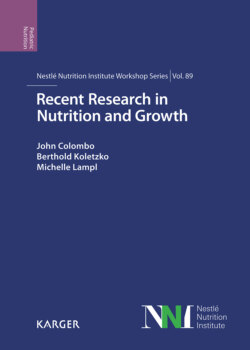Читать книгу Recent Research in Nutrition and Growth - Группа авторов - Страница 27
На сайте Литреса книга снята с продажи.
Introduction
ОглавлениеHuman stature by and large reflects axial growth of the long bones in the skeleton (Fig. 1a). The process of elongation is achieved by the activity of the growth plates, which are located peripherally at the distal and the proximal ends of the long bones between the epiphysis and the metaphysis (Fig. 1b). The growth plates are disks of hyaline cartilage, which is avascular, alymphatic, and aneural. The cartilaginous tissue consists solely of cells (chondrocytes) and an extracellular matrix [1], which contains water (70%) and organic macromolecules (30%). The latter includes collagenous fibrils, which are responsible for the tensile strength of the tissue, and proteoglycans (aggrecans), which, by virtue of their underhydrated state, build up an internal pressure of 2 atm, wherein lies the compressive strength of cartilage [2]. The activity of a growth plate underlies the tremendous increase in the axial length of the metaphyseal bony trabeculae that is achieved between fetal life and adulthood. The lateral growth of the long bones, viz, their increase in girth, is comparatively small and achieved by the subperiosteal direct apposition of osseous tissue [3]. The growth and the shaping of the epiphysis is effected by the layer of articular cartilage, which has a dual function this process (Fig. 1b), acting on the one hand in the capacity of a superficial growth plate [4] and on the other in the traditional role of assuring the frictionless movement of the long bones in the synovial joints.
Fig. 1. a Scale drawing of a newborn (black) and an adult (outlined only) human femur, illustrating the tremendous increase in length that is achieved during the phase of postnatal growth; lateral expansion is, on the other hand, fairly limited (modified after Fischel [33]). b Schematic representation of a growing long bone, illustrating its structural subdivision into epiphysis (E), metaphysis (M), and diaphysis (D). The epiphyseal bone is covered by a layer of articular cartilage, which is responsible for its enlargement (↖ ↑ ↗). Interposed between the epiphysis and the metaphysis is the growth plate cartilage, which effects bone elongation (↑↑↑). Lateral expansion of the growth plate originates at the perichondral ring of La Croix (Ranvier), which is located at its periphery (← →). Reproduced from Hunziker [7] with the publisher’s permission.
Between fetal life and adulthood, the rate of cartilaginous tissue produced by a growth plate varies characteristically at different landmark phases [5]. Nevertheless, the height of the structure does not undergo any great changes, since the neoformed cartilaginous tissue is resorbed at the same rate as it is produced. This chapter affords an overview of the structure and function of the growth plate at the histological and the cellular level, an insight into the mechanism that underlies the regulation of its activity, and a description of the most notable pathologies that afflict it.
Fig. 2. a Light micrograph of a section through the proximal tibial growth plate of a 35-day-old Wistar rat, glutaraldehyde-fixed in the presence of ruthenium hexamine trichloride (RHT) and stained with toluidine blue O. The chondrocytes are organized into axial columns, which are histogenetic entities, and represent the functional units for longitudinal growth. Synchronization of cell activities between lateral neighbors gives rise to the horizontal stratification: resting zone (RZ); proliferative zone (PZ); upper hypertrophic zone (UHZ); lower hypertrophic zone (LHZ); and zone of vascular invasion (IZ). b Electron micrograph illustrating the cartilage-matrix compartments in the hypertrophic zone of the rat growth plate (glutaraldehyde fixed in the presence of RHT). C, cytoplasm of chondrocytes; P, pericellular matrix, rich in proteoglycans and devoid of collagenous fibrils; T, territorial matrix, characterized by a network-like arrangement of collagenous fibrils, between which proteoglycans are interspersed; I, interterritorial matrix, characterized by longitudinally organized collagenous fibrils. Reproduced from Hunziker [26] with the publisher’s permission.
